Rebecca D. Elswick's Blog, page 3
June 20, 2014
Teachers Teaching Teachers
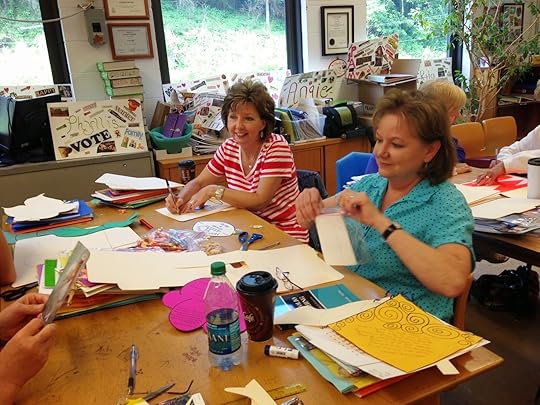 Robin Belcher (kindergarten) and her sister Tammie Davis (2nd grade)This week I had the opportunity to teach a writing workshop for thirteen teachers from Buchanan and Dickenson County. The class was called Writing Strategies for Every Classroom Teacher and it was offered by the University of Virginia's College at Wise and the Appalachian Writing Project (AWP). Since 2006, I have been a teacher consultant for AWP which is a branch of the National Writing Project (NWP), and I have given in-services for teachers across southwestern Virginia.
Robin Belcher (kindergarten) and her sister Tammie Davis (2nd grade)This week I had the opportunity to teach a writing workshop for thirteen teachers from Buchanan and Dickenson County. The class was called Writing Strategies for Every Classroom Teacher and it was offered by the University of Virginia's College at Wise and the Appalachian Writing Project (AWP). Since 2006, I have been a teacher consultant for AWP which is a branch of the National Writing Project (NWP), and I have given in-services for teachers across southwestern Virginia.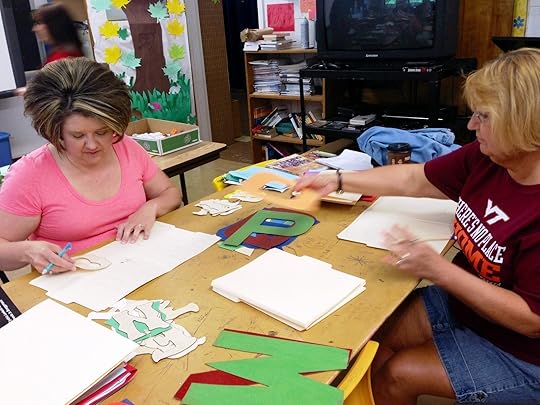 Carolyn Mitchell (special education) and Phyllis Mullins (7th civics)
Carolyn Mitchell (special education) and Phyllis Mullins (7th civics)
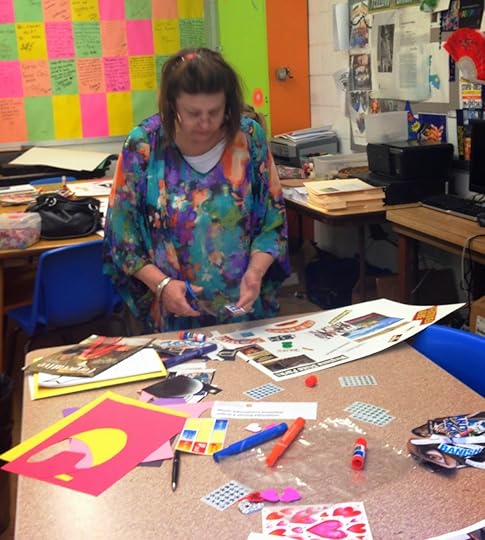 Wanda Perry teaches K-5 Art and MusicNWP is a network of sites anchored at colleges and universities and serving teachers across disciplines and at all levels, early childhood through university. NWP provides professional development, develops resources, generates research, and acts on knowledge to improve the teaching of writing and learning in schools and communities. Co-directed by faculty from the local university and from K–12 schools, nearly 200 local sites serve all 50 states, the District of Columbia, Puerto Rico, and the U.S. Virgin Islands. Sites work in partnership with area school districts to offer high-quality professional development programs for educators (www.nwp.org).
Wanda Perry teaches K-5 Art and MusicNWP is a network of sites anchored at colleges and universities and serving teachers across disciplines and at all levels, early childhood through university. NWP provides professional development, develops resources, generates research, and acts on knowledge to improve the teaching of writing and learning in schools and communities. Co-directed by faculty from the local university and from K–12 schools, nearly 200 local sites serve all 50 states, the District of Columbia, Puerto Rico, and the U.S. Virgin Islands. Sites work in partnership with area school districts to offer high-quality professional development programs for educators (www.nwp.org).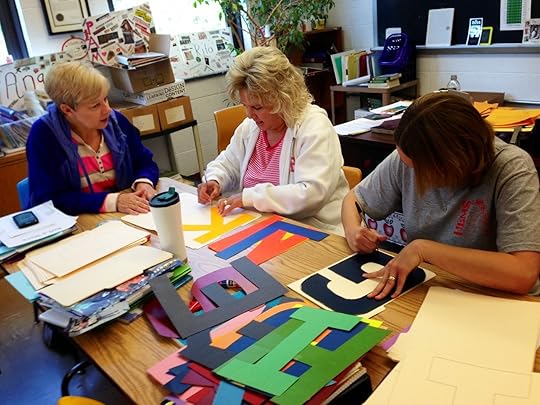 Dot Owens (1st) and Rebecca Burniston and Codi Layne (Pre-K)
Dot Owens (1st) and Rebecca Burniston and Codi Layne (Pre-K)I began the week with writing activities I had used with my students because NWP is based on the principle of teachers teaching teachers their best practices of teaching writing across the curriculum. Some of the activities I provided centered on using the students' "favorite subject" - themselves! We also discussed how students can write about themselves using multigenres.
The workshop also featured presentations by other members of AWP. TC Tammy Williams showed us how to use books to produce great "opening lines" for our writing.
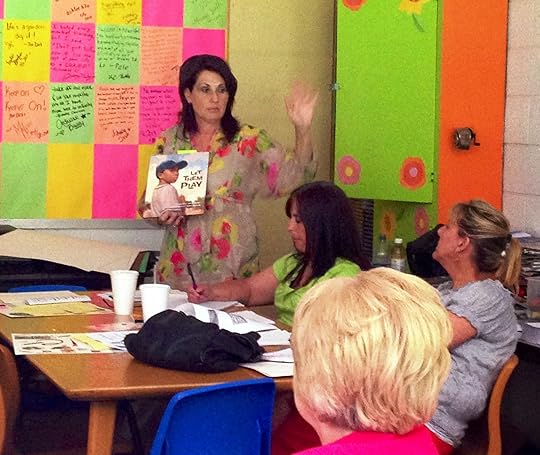 Teacher Consultant Tammy WilliamsTC Amber Couch discussed how to do research with our students using the I-Search method. She gave us strategies for teaching students how to form their research questions as well as conduct the research and put it together into a paper. A librarian, Amber talked about how students use the library to conduct research.
Teacher Consultant Tammy WilliamsTC Amber Couch discussed how to do research with our students using the I-Search method. She gave us strategies for teaching students how to form their research questions as well as conduct the research and put it together into a paper. A librarian, Amber talked about how students use the library to conduct research.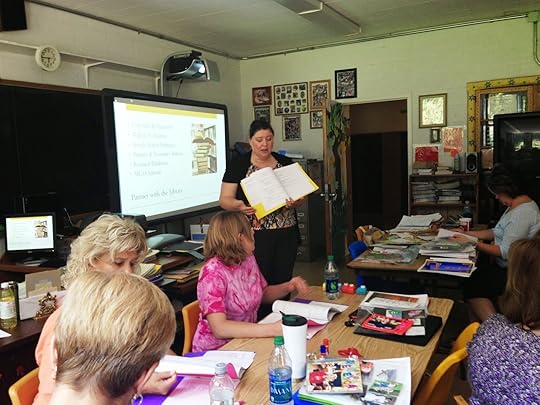 Teacher Consultant Amber Couch
Teacher Consultant Amber CouchTC Robin Justus ended the workshop with her presentation - Book Arts. Robin brought materials and led us through making books of all shapes and sizes while giving us strategies how to use them with our students. We practiced making books and had many examples to take back to our classrooms.
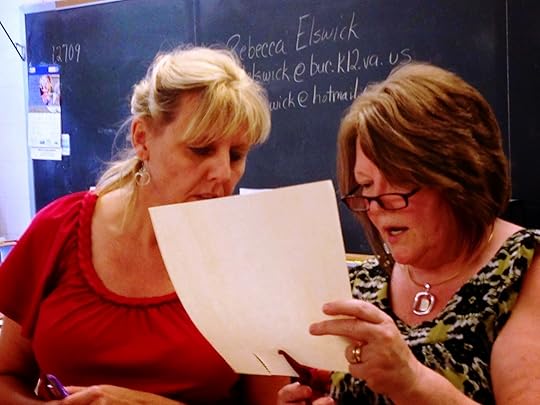 TC Robin Charles shows Angie Slemp how to cut the pages
TC Robin Charles shows Angie Slemp how to cut the pages.
The teachers attending the workshop also shared their ideas. The teachers brought an activity they have success with in the classroom and shared it with the group.Teachers teaching teachers in action!
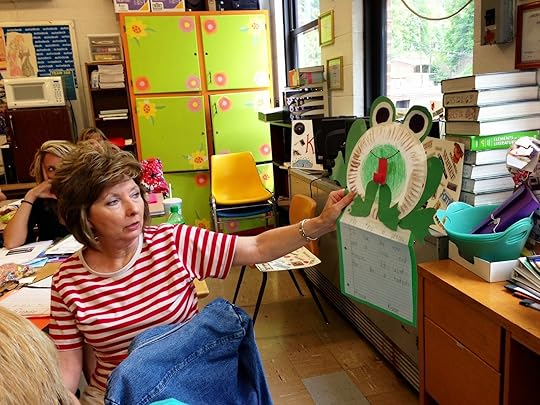 Robin Belcher shared a "froggy" idea.
Robin Belcher shared a "froggy" idea.
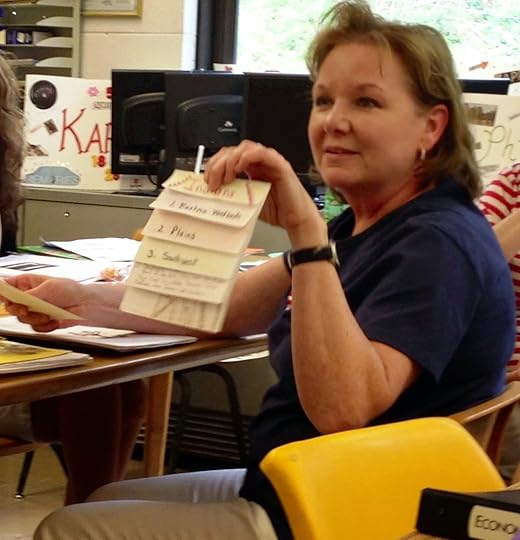 Tammie Davis
Tammie Davis 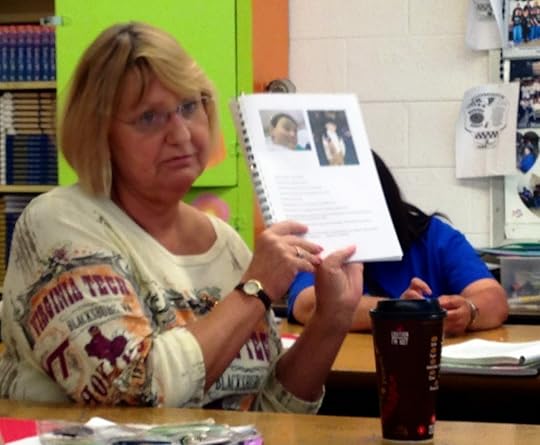 Phyllis Mullins
Phyllis Mullins 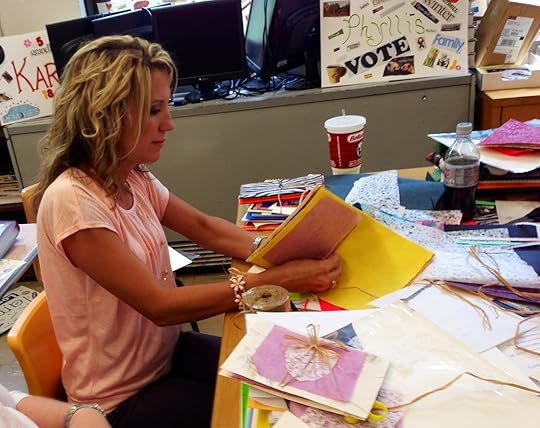 Tabitha Keen binding a book.The week was filled with learning new ways to add more writing into our classes. It didn't matter that our group ranged from Pre-K teachers to 7th grade civics, we all found activities that could be adapted to our grade levels and subject area. After all, no one can take a paper towel roll, empty oatmeal containers, yarn, glitter, and glue and produce a masterpiece like a teacher.
Tabitha Keen binding a book.The week was filled with learning new ways to add more writing into our classes. It didn't matter that our group ranged from Pre-K teachers to 7th grade civics, we all found activities that could be adapted to our grade levels and subject area. After all, no one can take a paper towel roll, empty oatmeal containers, yarn, glitter, and glue and produce a masterpiece like a teacher. 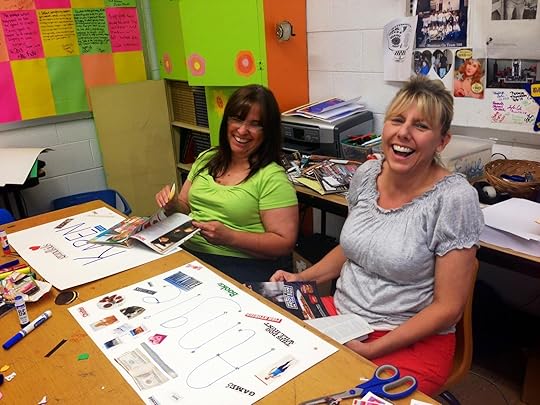 Karen Coleman and Angie SlempThe week was filled with laughter and learning, writing and sharing (which produced a few tears), but it was a fun-filled learning experience for all. At the end of the workshop, I got a profusion of thank you's from teachers who went out the door carrying activities they could implement in their classes on the first day of school. The class had achieved its goal - Writing Strategies for Every Classroom Teacher.
Karen Coleman and Angie SlempThe week was filled with laughter and learning, writing and sharing (which produced a few tears), but it was a fun-filled learning experience for all. At the end of the workshop, I got a profusion of thank you's from teachers who went out the door carrying activities they could implement in their classes on the first day of school. The class had achieved its goal - Writing Strategies for Every Classroom Teacher. 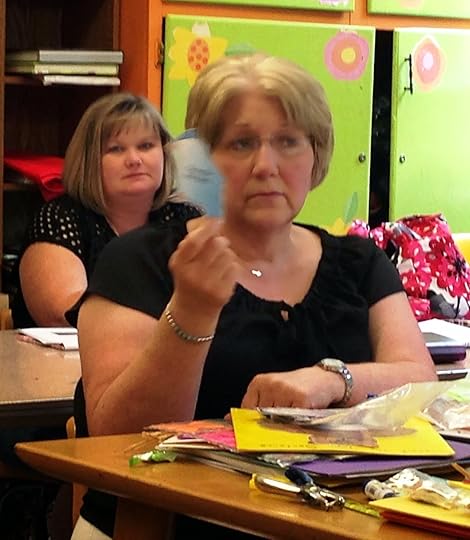 Rita Baily and Pam Fields
Rita Baily and Pam Fields
Published on June 20, 2014 21:31
June 4, 2014
My Review of Amy Greene's Long Man
As a teacher, I always look forward to my first summer read - the book I choose to kick off my summer vacation from school. This summer's choice is especially important because I decided, after much soul-searching, to retire from teaching, so I wanted a special book that would mark this milestone in my life. Well, I found it. Long Man by Amy Greene was the perfect choice.
Long Man is the story of what happens in the eastern Tennessee town of Yuneetah, during three days in the summer of 1936. An entire town and way of life for its inhabitants is about to be wiped out when the TVA (Tennessee Valley Authority) completes its project to dam the river Long Man and flood Yuneetah. There's just one problem, three year old Gracie Dodson disappears as the flood waters are rising faster than expected because of a raging storm.
Gracie Dodson is in harms way because her mother, Annie Clyde has refused to leave her 40 acre farm, a farm her ancestors have owned for generations. Even though Annie Clyde's husband wants to make a fresh start in Michigan where he believes they will have a better life, Annie Clyde is determined to remain a farmer. The land means everything to Annie Clyde. She believes a hard scrabble life toiling on the farm is better than the unknown.
As the deadline looms, a powerful storm hits. The storm is a metaphor on many levels - the fight between Annie Clyde and her husband; the fight between Annie Clyde and the TVA man; and the fight between Annie Clyde and Amos, the drifter she believes has taken her child. Perhaps the biggest storm in Annie Clyde's life is the loss of her land and the history it stands for.
The search for Gracie Dodson is as powerful as the force of the river Long Man. The pain Annie Clyde and her husband go through is palpable and heart-wrenching. The way the remaining townspeople, their families, and even the TVA man bond together to search for Gracie a testament to humanity. The possible loss of a child puts the flooding of this town into perspective, and it reminds the reader of the sacrifices made by people like the Dodsons in the name of progress.
The characters are vivid and tragic, each one having to deal with the loss of the only life they have ever known. This book is a testament to family and what it means to be connected to the land you love.
Long Man is the story of what happens in the eastern Tennessee town of Yuneetah, during three days in the summer of 1936. An entire town and way of life for its inhabitants is about to be wiped out when the TVA (Tennessee Valley Authority) completes its project to dam the river Long Man and flood Yuneetah. There's just one problem, three year old Gracie Dodson disappears as the flood waters are rising faster than expected because of a raging storm.
Gracie Dodson is in harms way because her mother, Annie Clyde has refused to leave her 40 acre farm, a farm her ancestors have owned for generations. Even though Annie Clyde's husband wants to make a fresh start in Michigan where he believes they will have a better life, Annie Clyde is determined to remain a farmer. The land means everything to Annie Clyde. She believes a hard scrabble life toiling on the farm is better than the unknown.
As the deadline looms, a powerful storm hits. The storm is a metaphor on many levels - the fight between Annie Clyde and her husband; the fight between Annie Clyde and the TVA man; and the fight between Annie Clyde and Amos, the drifter she believes has taken her child. Perhaps the biggest storm in Annie Clyde's life is the loss of her land and the history it stands for.
The search for Gracie Dodson is as powerful as the force of the river Long Man. The pain Annie Clyde and her husband go through is palpable and heart-wrenching. The way the remaining townspeople, their families, and even the TVA man bond together to search for Gracie a testament to humanity. The possible loss of a child puts the flooding of this town into perspective, and it reminds the reader of the sacrifices made by people like the Dodsons in the name of progress.
The characters are vivid and tragic, each one having to deal with the loss of the only life they have ever known. This book is a testament to family and what it means to be connected to the land you love.
Published on June 04, 2014 14:37
•
Tags:
amy-greene, depression, flood, long-man
My Review of Long Man by Amy Greene
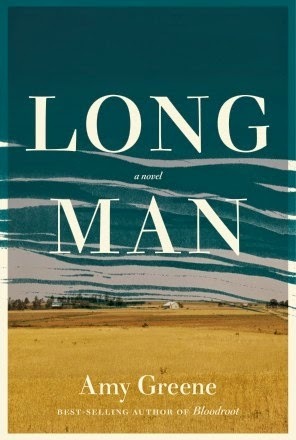 As a teacher, I always look forward to my first summer read - the book I choose to kick off my summer vacation from school. This summer's choice is especially important because I decided, after much soul-searching, to retire from teaching, so I wanted a special book that would mark this milestone in my life. Well, I found it.
Long Man
by Amy Greene was the perfect choice.
As a teacher, I always look forward to my first summer read - the book I choose to kick off my summer vacation from school. This summer's choice is especially important because I decided, after much soul-searching, to retire from teaching, so I wanted a special book that would mark this milestone in my life. Well, I found it.
Long Man
by Amy Greene was the perfect choice.Long Man is the story of what happens in the eastern Tennessee town of Yuneetah, during three days in the summer of 1936. An entire town and way of life for its inhabitants is about to be wiped out when the TVA (Tennessee Valley Authority) completes its project to dam the river Long Man and flood Yuneetah. There's just one problem, three year old Gracie Dodson disappears as the flood waters are rising faster than expected because of a raging storm.
Gracie Dodson is in harms way because her mother, Annie Clyde has refused to leave her 40 acre farm, a farm her ancestors have owned for generations. Even though Annie Clyde's husband wants to make a fresh start in Michigan where he believes they will have a better life, Annie Clyde is determined to remain a farmer. The land means everything to Annie Clyde. She believes a hard scrabble life toiling on the farm is better than the unknown.
As the deadline looms, a powerful storm hits. The storm is a metaphor on many levels - the fight between Annie Clyde and her husband; the fight between Annie Clyde and the TVA man; and the fight between Annie Clyde and Amos, the drifter she believes has taken her child. Perhaps the biggest storm in Annie Clyde's life is the loss of her land and the history it stands for.
The search for Gracie Dodson is as powerful as the force of the river Long Man. The pain Annie Clyde and her husband go through is palpable and heart-wrenching. The way the remaining townspeople, their families, and even the TVA man bond together to search for Gracie a testament to humanity. The possible loss of a child puts the flooding of this town into perspective, and it reminds the reader of the sacrifices made by people like the Dodsons in the name of progress.
The characters are vivid and tragic, each one having to deal with the loss of the only life they have ever known. This book is a testament to family and what it means to be connected to the land you love.
Published on June 04, 2014 09:40
May 3, 2014
My Day at The Tales of the Lonesome Pine Bookstore
It was a beautiful day to trek over the mountain to Big Stone Gap, Va. The temperature hovered just below seventy and the blooming trees and flowers swayed in the breeze. It was wonderful to have the sun follow me on my journey, like a long lost friend. Memories of the bone chilling winter are still too close to the surface for me! A day like today was just what I needed to renew my spirit.
I made it to my destination, The Tales of the Lonesome Pine Bookstore, before noon. Wendy Welch, who owns and operates the store was celebrating a Spring Authors Fair. I joined local authors, Chrissie Anderson Peters, Adam Lawler, Sylvia Nichols, Claudia Ware, and Mary Ann Artrip.
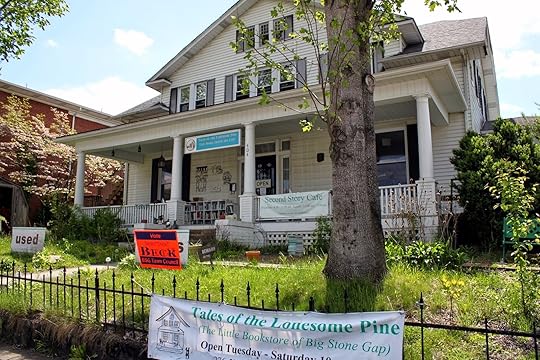
We spent the day in this beautiful house/bookstore/cafe, chatting with people who wandered through the rooms that are filled with books. My "spot" was at this table under this beautiful quilt.
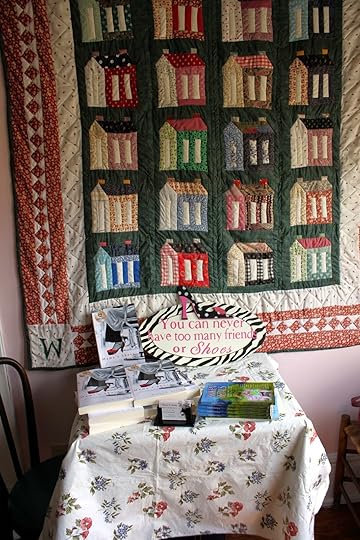 It was next to windows that looked out over the back of the house. I sat there and enjoyed the breeze wafting in the window, bringing with it the sounds of the neighborhood - dogs barking, cars passing, people outside enjoying the day - while I visited with everyone. Somehow, the people didn't "feel" like customers who were there to buy books, but rather friends coming to visit.
It was next to windows that looked out over the back of the house. I sat there and enjoyed the breeze wafting in the window, bringing with it the sounds of the neighborhood - dogs barking, cars passing, people outside enjoying the day - while I visited with everyone. Somehow, the people didn't "feel" like customers who were there to buy books, but rather friends coming to visit.
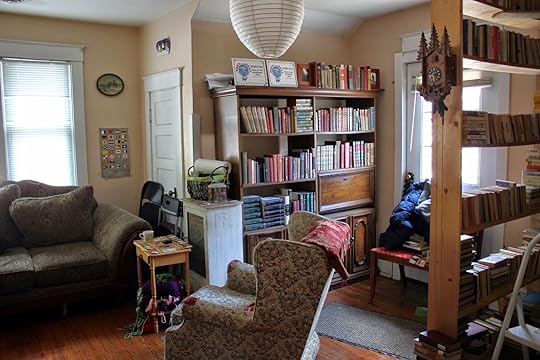
The entire house is filled with books, but the rooms are also "homey" and of course, inviting. It's not unusual to see a cat sunning in front of a window, totally unperturbed by the people looking at books right next to her.
Upstairs, is a cafe where many people came to eat. The rooms set aside for the cafe reminded me of places where I'd dined while I was in Ireland. The entire house seemed to say, "Come on in! There's room for everyone!"
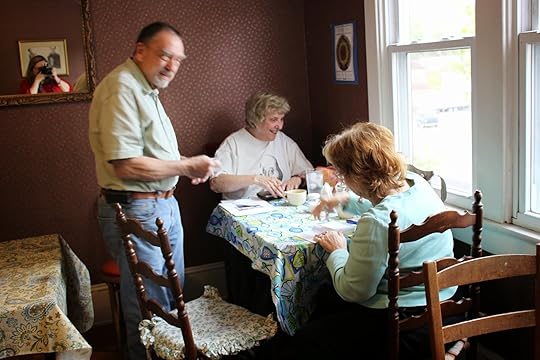
To say I enjoyed my day at The Tales of the Lonesome Pine is an understatement. There's nothing a book-loving, word-nerd likes better than a bookstore filled with kindred wordsmiths. I even got to talk about writing and publishing with them.
But all good things must come to an end, and the day flew by. When I got in my car to leave, I looked back at the store and watched people linger on the porch. They were obviously enjoying each others company and of course, they were carrying books. It made me smile. Then I saw a man bend over and pet a big fluffy cat lounging in the yard. I watched while he hefted it up, talking away to him?her? I laughed and drove away, promising myself that I would return soon to the little bookstore in the big house.
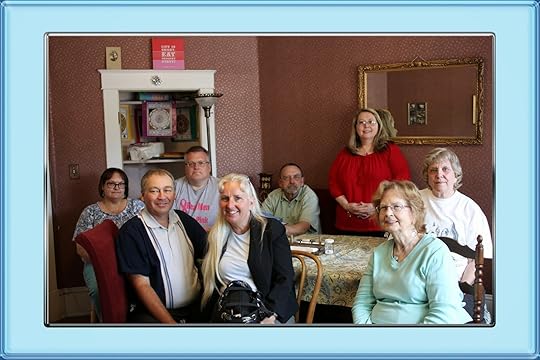
I made it to my destination, The Tales of the Lonesome Pine Bookstore, before noon. Wendy Welch, who owns and operates the store was celebrating a Spring Authors Fair. I joined local authors, Chrissie Anderson Peters, Adam Lawler, Sylvia Nichols, Claudia Ware, and Mary Ann Artrip.

We spent the day in this beautiful house/bookstore/cafe, chatting with people who wandered through the rooms that are filled with books. My "spot" was at this table under this beautiful quilt.
 It was next to windows that looked out over the back of the house. I sat there and enjoyed the breeze wafting in the window, bringing with it the sounds of the neighborhood - dogs barking, cars passing, people outside enjoying the day - while I visited with everyone. Somehow, the people didn't "feel" like customers who were there to buy books, but rather friends coming to visit.
It was next to windows that looked out over the back of the house. I sat there and enjoyed the breeze wafting in the window, bringing with it the sounds of the neighborhood - dogs barking, cars passing, people outside enjoying the day - while I visited with everyone. Somehow, the people didn't "feel" like customers who were there to buy books, but rather friends coming to visit.
The entire house is filled with books, but the rooms are also "homey" and of course, inviting. It's not unusual to see a cat sunning in front of a window, totally unperturbed by the people looking at books right next to her.
Upstairs, is a cafe where many people came to eat. The rooms set aside for the cafe reminded me of places where I'd dined while I was in Ireland. The entire house seemed to say, "Come on in! There's room for everyone!"

To say I enjoyed my day at The Tales of the Lonesome Pine is an understatement. There's nothing a book-loving, word-nerd likes better than a bookstore filled with kindred wordsmiths. I even got to talk about writing and publishing with them.
But all good things must come to an end, and the day flew by. When I got in my car to leave, I looked back at the store and watched people linger on the porch. They were obviously enjoying each others company and of course, they were carrying books. It made me smile. Then I saw a man bend over and pet a big fluffy cat lounging in the yard. I watched while he hefted it up, talking away to him?her? I laughed and drove away, promising myself that I would return soon to the little bookstore in the big house.

Published on May 03, 2014 20:44
March 20, 2014
&nb...
Broken Petals
If I live to be a hundred, and have a hundred press releases to my credit, I will never loose the thrill of seeing my name on one! But the wait! Oh, my! Waiting for a book to hit the shelves is a frustrating process that will test the nerves of the most seasoned author. "When is the book coming out?" That is a question that no doubt authors hear many times as the day draws near, and for me, it always makes me anxious. Waiting to see my work - my imagination in a form I can actually hold in my hands is a thrill like all my birthdays and Christmases rolled into one!
I had that thrill today! An anthology of short stories, Broken Petals, was officially released, and I am proud to have a story in the collection. My story, "Abby's Secret" is a dark tale about childhood. It is the story of a lonely little girl who lives the life 'children are to be seen and not heard,' and because of this unspoken rule, she is forced to give up the one thing she loves - the one thing in her life she is proud of - without speaking a word.
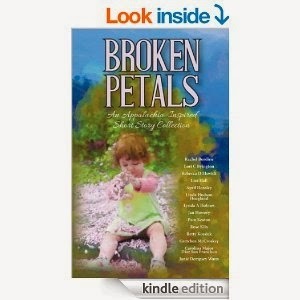 FOR IMMEDIATE RELEASE
FOR IMMEDIATE RELEASE
Wednesday, March 19, 2014Contact: Jan-Carol Publishing, Incpublicity@jancarolpublishing.com
New Anthology FeaturesAppalachia-Inspired Short Stories
Jan-Carol Publishing, Inc, of Johnson City, Tennessee, is proud to announce the release of Broken Petals, an anthology of inspirational short stories. The 14 stories comprise the winning selections from the 2013 contest sponsored by Voice Magazine. The authors represented are Rachel Burdine, Lori C Byington, Rebecca D Elswick, Lisa Hall, April Hensley, Linda Hudson Hoagland, Lynda A Holmes, Jan Howery, Pam Keaton, Rose Klix, Betty Kossick, Gretchen McCroskey, Carolina Major Diaz San Francisco, and Janie Dempsey Watts. These talented writers all have connections to Appalachia even though they now live in various parts of Tennessee, Virginia, Georgia, New England, and the Midwest. Each in its own way, the stories show how personal character, tenacity, and humor emerge and persevere despite hardships and dark times. The narratives intertwine traditional Appalachian teachings and influences with today’s context and challenges.
Publisher Janie Jessee explains, “Hopefully the stories in Broken Petals remind readers that when we acceptan outstretched hand, we gain an inner strength that creates a harmony in unity with beauty, compassion, and determination. This is healing, much like when broken flower petals are bound together: they create a bouquet of beauty, sweet fragrance, and originality in the face of uncompromising endurance.”
Jan-Carol Publishing, Inc, includes the imprints Mountain Girl Press, Little Creek Books, Express Editions, RoseHeart Publishing, and DigiStyle. Each imprint specializes in a particular genre—from local Appalachian stories to children’s books and more. At JCP, we believe ‘Every story needs a book.’
For more information or to schedule a book signing, call Jan-Carol Publishing, Inc, at 423-926-9983, or visit jancarolpublishing.com. Follow JCP on Facebook.
The book is available on Amazon in paperback or Kindle, and at Barnes and Noble in paperback or Nook. Or, you can contact me! rdelswick@hotmail.com
If I live to be a hundred, and have a hundred press releases to my credit, I will never loose the thrill of seeing my name on one! But the wait! Oh, my! Waiting for a book to hit the shelves is a frustrating process that will test the nerves of the most seasoned author. "When is the book coming out?" That is a question that no doubt authors hear many times as the day draws near, and for me, it always makes me anxious. Waiting to see my work - my imagination in a form I can actually hold in my hands is a thrill like all my birthdays and Christmases rolled into one!
I had that thrill today! An anthology of short stories, Broken Petals, was officially released, and I am proud to have a story in the collection. My story, "Abby's Secret" is a dark tale about childhood. It is the story of a lonely little girl who lives the life 'children are to be seen and not heard,' and because of this unspoken rule, she is forced to give up the one thing she loves - the one thing in her life she is proud of - without speaking a word.
 FOR IMMEDIATE RELEASE
FOR IMMEDIATE RELEASE Wednesday, March 19, 2014Contact: Jan-Carol Publishing, Incpublicity@jancarolpublishing.com
New Anthology FeaturesAppalachia-Inspired Short Stories
Jan-Carol Publishing, Inc, of Johnson City, Tennessee, is proud to announce the release of Broken Petals, an anthology of inspirational short stories. The 14 stories comprise the winning selections from the 2013 contest sponsored by Voice Magazine. The authors represented are Rachel Burdine, Lori C Byington, Rebecca D Elswick, Lisa Hall, April Hensley, Linda Hudson Hoagland, Lynda A Holmes, Jan Howery, Pam Keaton, Rose Klix, Betty Kossick, Gretchen McCroskey, Carolina Major Diaz San Francisco, and Janie Dempsey Watts. These talented writers all have connections to Appalachia even though they now live in various parts of Tennessee, Virginia, Georgia, New England, and the Midwest. Each in its own way, the stories show how personal character, tenacity, and humor emerge and persevere despite hardships and dark times. The narratives intertwine traditional Appalachian teachings and influences with today’s context and challenges.
Publisher Janie Jessee explains, “Hopefully the stories in Broken Petals remind readers that when we acceptan outstretched hand, we gain an inner strength that creates a harmony in unity with beauty, compassion, and determination. This is healing, much like when broken flower petals are bound together: they create a bouquet of beauty, sweet fragrance, and originality in the face of uncompromising endurance.”
Jan-Carol Publishing, Inc, includes the imprints Mountain Girl Press, Little Creek Books, Express Editions, RoseHeart Publishing, and DigiStyle. Each imprint specializes in a particular genre—from local Appalachian stories to children’s books and more. At JCP, we believe ‘Every story needs a book.’
For more information or to schedule a book signing, call Jan-Carol Publishing, Inc, at 423-926-9983, or visit jancarolpublishing.com. Follow JCP on Facebook.
The book is available on Amazon in paperback or Kindle, and at Barnes and Noble in paperback or Nook. Or, you can contact me! rdelswick@hotmail.com
Published on March 20, 2014 19:30
December 29, 2013
Year End Clearance

Year End Clearance - you see these words everywhere - on TV, in newspapers and magazines, in store windows, and of course, online. It's understandable that stores are clearing out their inventories to make way for the next surge of merchandise. And for bargain hunters - it can be a veritable feast! With the new year upon us, I decided that instead of resolutions, I would conduct my personal Year End Clearance. Before I can focus on what I'm going to do next year, I first need to clear out all those things that are still in my "inventory" from this year.
First and foremost, I must clear out all of my old teacher-files. I am retiring at the end of this school year, and will no longer be teaching high school. (Big Deep Breath) It's time to clear that part of my life from my plate and make room for my new full-time writing life.
Second, I must clear out the physical clutter in my life. We have been remodeling for the better part of two years and its time to GET IT FINISHED.
Third, I must clear away any old "hurts" or "slights" (real or imagined) that I have been carrying around inside of me. I must remember what is important and what truly matters. It's a waste of valuable space to keep hurtful words inside of yourself. Clear those away and let love take root in that space.
It's a BIG job, but one with many benefits. While I sift through my inventory, I can reflect on what I want to keep and what I want to throw away or give away. I can also discover what 's missing and what I need to add to my stock. The important thing is to make sure I rid myself of the things that don't matter and only add the things that do.
In the words of Laura Ingalls Wilder,“The real things haven't changed. It is still best to be honest and truthful; to make the most of what we have; to be happy with simple pleasures; and have courage when things go wrong.”

Published on December 29, 2013 16:08
November 4, 2013
Grave Dressing
Spring is the time of naissance. Stories abound about the rituals and celebrations of spring that bind our human fates with the cycle of nature. It’s during spring that the sun teases the plants from the ground, and the animals fill the barns and fields with their young. In central Appalachia, it’s during this season of birth that the long-standing ritual of grave dressing begins.Central Appalachia is in the oldest mountain range in North America. In this beautiful and rugged place, that I call home, small towns and communities are the way of life. Small town life taught me to have a strong sense of place and a great love for, and pride in, my heritage. My Appalachian legacy includes its folktales, legends, superstitions, and traditions. One of its oldest traditions is the rituals that surround death.Family cemeteries, or graveyards as they tend to be called, dot the mountainsides and church yards in this rural part of the country. The number of graves in these cemeteries range from a single family to generations of the same family. In central Appalachia, graves are not kept to areas designated as cemeteries, but can be found on a hillside adjacent to a house or even in the backyard.Often, I pass by a small lot next to the road; on it is a mobile home that has a grave in the front yard. The teddy bear tombstone claims it is a child’s burial place. Even when the yard isn’t mown, the area around the tombstone is pristine. As the years go by, the absence of toys in the yard and the empty front porch is like a spotlight on the child’s grave. No matter what story I imagine about this place, there are no happy endings.Funeral services in central Appalachia are still dictated by religious practices and family traditions. As old-fashioned as they may seem to some, in truth, today’s funerals bear little resemblance to those of a hundred years ago, when families took care of the wake and the burial. The absence of undertakers and funeral homes as well as the lack of church buildings made home services the norm. In those days, the women prepared the body while the men hand-dug the grave. The coffin was made by the local carpenter or a family member who was handy with tools, and the women lined it with cloth or a funeral quilt – a quilt made for this express purpose.Houses were built with a window in the front room wide enough to get the coffin into the house, and the body was always ‘brought home’ to be made ready for burial. If the family owned a clock, it was stopped at the time of death and any mirrors in the home were covered. Often pennies, or sometimes nickels, were placed over the closed eyes of the dead.When everything was prepared, the wake was held before burial. Since a hundred years ago, ministers in this area were in short supply, there was no actual service. Family and neighbors brought food, and often moonshine, to the home of the deceased. Women were supposed to cry over the dead while the men stayed in the background. At night, family members were expected to “set-up” with the body, because an old mountain superstition decreed the soul didn’t leave the body until twenty-four hours after death; therefore, someone had to keep the soul company and make sure the devil didn’t steal it away. When the undertaker arrived in this area, death practices began to change. The modern funeral home changed them even more, but some of the old rites are still practiced. Today, funerals may take place at the funeral home or in a church instead of the deceased’s home, but the tradition of ‘setting up’ with the body is still observed. After friends and family pay their respects, a practice now called ‘visitation,’ chosen family members stay with the body all night. Internment in a family graveyard, instead of a large public cemetery, is still the norm in central Appalachia. Location of the cemetery dictates how the burial takes place. Family plots are often on steep ridges in out of the way places. Some don’t have roads that are passable, making it impossible for a hearse or even a four-wheel drive vehicle to get the body to the grave. In days past, a wagon pulled by a horse or mule would be used to get the coffin to the graveyard. Today, the coffin must be carried to a grave that has to be hand-dug because it is impossible for a backhoe to get to the grave site. Burial is also done by hand, with the pallbearers lowering the casket and filling in the grave.
The old family cemeteries are some of central Appalachia’s most beautiful landmarks because families embrace the ritual of grave dressing. This seasonal activity is especially important after winter has ravaged the landscape. Decorating family graves is as much an Appalachian tradition as eating soup beans with cornbread. For some, it’s a simple affair of mowing grass, removing old arrangements and installing new ones, but to some families, it is a ritual that has become a family ceremony as worshipful as the funeral.When the grass greens and the sun warms the earth, it’s time to make the trek to the family graveyards. This is an important ritual for my family, and on the appointed day, I arrive at our family cemetery early, so I can wander through the uneven rows of old graves alone. The beauty of spring juxtaposed with death doesn’t escape me. I sit under a poplar tree and look out at my history; the most recent chronicle being the graves of my sister and father. As the breeze, with winters chill still upon it surrounds me, I think of these lines from Walt Whitman’s poem “Leaves of Grass”:
I WAS looking a long while for a clue to the history of the past for myself, and for these chants—and now I have found it;
It is not in those paged fables in the libraries, (them I neither accept nor reject;)
It is no more in the legends than in all else;
It is in the present—it is this earth to-day;
When my mother arrives, it takes some time to spread out the paraphernalia she needs to dress the graves: bottle of soapy water, gallon of freshwater, bottle of baby oil, brush, various rags, and of course, two large bags that hold the new arrangements. I discover she has added a new tool to her arsenal - a pair of small grass clippers, battery operated, and fully charged. I ask her what I can do, but she waves me away while she, “cuts a little grass” around the graves. I watch her for a while, amazed at how she can bend and cut so carefully and methodically when at eighty-nine, she suffers from arthritis and osteoporosis. Her back is bowed from an old fracture to her spine. I know she suffers pain, but it doesn’t stop her; it merely slows her down.While she cuts, I wander around the cemetery. I see by the cut grass and bright spring flowers that other family members have been there to tend their branch of the family tree, but there are many graves waiting to be dressed, their vases holding weathered Christmas arrangements. It saddens to me that the favored flower, the silk red rose, looks the worst after a winter’s exposure. I find many arrangements whose roses are now the color of dried blood tinged in gray, and I want to change them to spring pinks, yellows, and oranges.Half an hour later, my mother is ready to clean the grave markers. She lets me pour the soapy water over them and use the soft brush to scrub away the dirt, taking special care to get inside the letters of the names. Mother watches me, instructing me like I have never done this before, and I get the sense that she is making sure I know what to do for the day when the side of the tombstone she shares with my father, bears not only her date of birth, but her date of death. I realize I have accepted the job of grave dresser, even though I was never formally asked.When the grave markers are rinsed and dried, she lets me apply the baby oil. This is her special trick to make the headstones shine. I rub it over the entire surface, taking special care to get inside the letters of the names. When she is satisfied, I step back and let her put the flowers in the vases. I have not earned the right to do this, not yet. I am merely a grave dresser in training. My mother makes the arrangements herself, and they are beautiful. They are full and lush, but not too tall, so the spring winds won’t blow them away. My sister’s and father’s arrangements are just alike, and in my mind’s eye, I watch her creating these arrangements, bent over her work, counting the orange tiger lilies, pink mums, yellow and orange zinnias to make sure there are equal numbers in each arrangement. There are sprigs of greenery and ivy, baby’s breath, and her signature touch – long green blades that look like sea grass. While she works, she talks of times gone by, of relatives I barely remember, if at all. As is her way, she speaks of them in present tense, reminding me her brother Roy “won’t eat breakfast without gravy on the table,” and her sister Frieda, “wore my new high heels out to the coal pile and left them. It snowed and ruined them, and Mommy didn’t even whip her.”Mother tells me of coming to this graveyard when she was a girl. She recalls that every spring, the whole family from all around, gathered for a big dinner on the ground. This dinner coincided with the coming of the traveling preacher. The family would hold a service at the cemetery for the dead who’d been buried in the time since the preacher had last visited. They called this custom of having a funeral after the fact, funeralizing.While I listen, I stand by, handing her pieces of Styrofoam and strips of florists’ green tape that she uses to anchor the flowers into the vases. I feel like a nurse handing instruments to a surgeon. When at last, she stands back to observe her creations, wondering aloud if they are secure enough, I see her eyes rest of the names of my sister – Jeannine, and my father, Frank. It’s now when she makes a remark that has “missing you” somewhere in it, and I know it’s almost time to leave. This year, her “missing you” remark was followed by “I’ll be seeing you soon.”At last, she stands for a minute in silence, then picks up a bag and starts packing her things. I help her put everything away and then carry it to her car. I walk back for her and together we walk to our cars. When we get to the road, she turns and looks back at the graves. She doesn’t comment on them, instead points out the kaleidoscope of colors that the cemetery now boasts. When she’s finished, I help her get in her car, seeing the pain on her face as she uses her hand to pick up her leg. We don’t talk about it because she doesn’t complain. The aches and pains of old age she bears in silence. She puts that pain alongside the grief she’s born for twenty years after losing her oldest child, added now to her newest grief of two years, the loss of my father.I watch her drive away and go back to the graves we’ve just tended. I sit down between them and turn my face toward the breeze. I breathe deeply. My hair blows back from my face. I imagine the wind says, thank you. After a while, I stand to leave and see others moving about the cemetery. I feel a sense of peace like I have been blessed by the hand of God. My heart is full with the blessing of it. I know that one day soon, I will be the one conducting this ritual, and my heart accepts it. I know, too, the day will come when I will take my place here next to my family, and other hands will dress my grave when spring returns to the mountains.
Published on November 04, 2013 19:33
September 10, 2013
You Started It!
If there’s one word a teacher hates to hear from a student it’s - FIGHT!
The word, FIGHT, is always accompanied by a sudden rush of students in the direction of the event, making it difficult for the peacemaking teachers to get to the action, so to speak. In my thirty-four years of teaching, I have seen my fair share of fights, heard about many more, and even gotten in the middle of a few (to put a stop to it). Most of the fights I’ve experienced were half-hearted attempts at violence, with excessive pushing (and cursing) or arms locked around each other in an awkward embrace (and cursing). Occasionally, there's a bloody nose, or the next day a black eye, but that's usually the extent of the damage. There have been a few exceptions.
The worst fights I have ever encountered were not big, hulking, teenage boys, bursting with hormones and full of piss and vinegar. The worst fights I have ever had to contend with were between girls, yes, I said girls. Girls hold nothing back – nothing. They fight to the death, and woe unto the girl who has long hair. Boys generally fight with their fists or the headlock grab. Girls go for the hair – every time. They twine the hair around and around their fingers and PULL with the strength that only righteous indignation can ignite. And girls scratch! They will sink their fingernails in any exposed flesh and rake and scrape. They also bite, spit, and kick.
What causes teens to resort to physical violence? Is it mere teenage angst? I think not. Ninety-nine percent of the time it's over the opposite sex. Ah, love! Shakespeare said it best, "O never say that I was false of heart." Real or imagined, most of the fights among teenagers are because "he said - she said, or she said - he said," and occasionally, it's "they said." These fights are the stuff songs are made of. Every time I hear of girls fighting over a boy I think of Loretta Lynn's song, "You Ain't Woman Enough," but those girls should be singing, "Before he Cheats" by Carrie Underwood. But I digress.
When I was a teenager, I would have never dared to get into a fight at school. I grew up with a brother two years my junior and believe me, we got into lots of arguments, but my mother had a way of nipping our fights in the bud. She hated to hear me say those three words: "He started it!" As much as she hated to hear my brother say, "She started it!" My mother knew just what to do to "finish it." She made us apologize and hug each other, and we had to "mean it" or we hugged until we did! If I had gotten into a fight at school, I have no doubt my mother would have marched into the principal's office and made me hug my opponent.
My goal is to teach my students that their real weapons are not their fists, but their words. Communication - the ability to express yourself with words - written or spoken, will accomplish more than your fists, and it's undeniably less painful. I tell my students that if you learn how to express yourself, people will listen. In the words of President John Adams, "Let us dare to read, think, speak, and write." I like to think he wouldn't mind if I added ...and don't fight.
Published on September 10, 2013 19:24
September 6, 2013
My Recent Interview about Mama's Shoes
http://bobmust.wordpress.com/2013/09/06/coal-country-and-the-strength-of-coal-women-an-interview-with-rebecca-elswick/
I was recently interviewed by Appalachian author Bob Mustin. You can visit his blog "Gridey Fires" and read the interview at the above address. I have also copied it below. Thanks, Bob! Coal Country and the Strength of Coal Women – An Interview with Rebecca Elswick Posted on September 6, 2013 by gridleyfires under Uncategorized, Books, Creative Writing, philosophy, History, Travel This is the third in Gridley Fires’ series of indie author interviews.
These interviews are with authors whose work shows great promise but still haven’t latched onto that larger audience. Hopefully these interviews will give the authors and their work a bit of a shove in the right direction. Rebecca Elswick, the subject of this interview, has had the earned fortune to have had a fine novel, Mama’s Shoes, published as a result of a Writer’s Digest contest. We think her insights into writing technique – as well as into her work itself – are certainly worth sharing here.
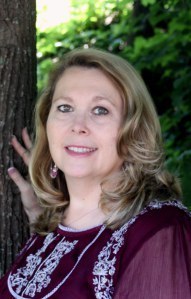
Gridley Fires: You’ve written a novel that spans quite a bit of time, including the World War II era. How did you decide to structure it as you did, moving back and forth in time, from the various characters’ points of view?
Rebecca Elswick: I wanted to begin the novel with Sassy’s point of view at an age when she would become aware that her mother was not like the other mothers in Coal Valley, so I decided to begin the story in the middle, after giving the reader a glimpse of Sylvia at age sixteen. This juxtaposed the world Sylvia anticipated at age sixteen with the world she ended up in at age thirty, leaving the reader to wonder – what happened?
GF: It seems you’ve given both Sylvia and Sassy equal time in this novel. Did you intend that, or do you consider one of them the primary character?
RE: Sylvia is the main character, but I wanted the story to be told from different points of view with the primary voice being her daughter, Sassy. I wanted to apply that old saying ‘there’s three sides to every story – mine, yours, and the truth.
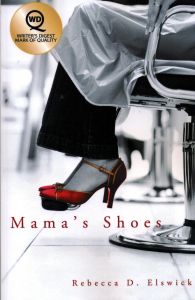
GF: Madge is a character unlike others in your book. How did you come up with her? As you look at her now, did she serve her intended purpose(s)?
RE: I am the daughter of a beautician and much of my “beauty shop” story is based on my memories of the beauty shops where my mama worked. Like Sassy, I would empty the ashtrays and fold towels and do other jobs, and like Sassy, I would listen to the women talk. There always seemed to be a “Madge” beautician in these places. She was the one who didn’t care what she said or to whom she said it. I wanted to have a character like that who would champion Sylvia. Madge served as my message that family doesn’t always mean blood kin. Madge was as much Sylvia and Sassy’s family as Aunt Hat. I also wanted a character who was more “Appalachian” than the others in her speech, upbringing, and actions.
GF: Sassy’s friend Kitty and her family are clearly there for comparison to Sylvia and Sassy. How would you characterize this comparison?
RE: Kitty and her family were important for two reasons: they were the key to Sassy’s past and therefore, Sylvia’s secret, and they were Sassy’s window to the outside world.
GF: You also deal with women’s issues, at least by implication. Do you see women’s social conditions as having improved since the time of your novel?
RE: It was important to me to portray my characters as strong, Appalachian women who were survivors in a place where life was harsh. These women came to the beauty shop when the coal mines were working and their husbands had money, and they stayed away when they didn’t. Getting their hair done every now and then was the only thing they ever did for themselves. I also wanted to explore post-partum depression or the “baby blues or birthing blues” as they were called at that time. I wanted to show how women were expected to bear this quietly or as Madge told Sylvia her mother said you were supposed to ‘suck it up and put your shoulder to the plow.’ Even before Sylvia’s husband dies in the war, it’s the post-partum depression that almost destroys her.
GF: Were you to place Sylvia in today’s world, how would she be different than in Mama’s Shoes?
RE: Women have so many more options than Sylvia did in the1940s and 50s. When Sylvia found herself at age sixteen, with both parents dead and nobody but a maiden aunt who lived across the country to care for her, she chose to marry a man almost ten years older than her. Sylvia had no hope of college or even high school in her day.
GF: I know you live in the southern Appalachians, in “coal country,” as you term it, and your novel is set there. Did you learn much about that area in your research for the novel, and in the writing?
RE: I did a tremendous amount of research because I wanted to portray this time in history correctly since it was a bit before my time! I researched the WWII information and used my father’s path through WWII for my character Gaines. My father was indeed, General Patton’s driver. I wanted Coal Valley to ring true like the coal mining towns around southwestern Virginia, eastern Kentucky, and southern West Virginia during the 1940S and 1950s. My grandfather was a coal miner and I had numerous stories to draw from from the people who lived in Grundy during this time.
GF: Are there more novels in your future? If so, what can you tell your readers about a next project?
RE: I have just completed my second novel. It takes place in a modern day Coal Valley. Two women meet on the day their daughters start kindergarten. One is born and raised in Coal Valley; the other is from the city, her husband dean of the new law school. Though opposites, they share one thing in common, they want to leave their husbands but for their daughters’ sake they cannot. They make a pact to leave their husbands when their daughters graduate from high school. The character from Coal Valley is the great granddaughter of Granny Zee (the mountain granny woman who delivers Sylvia in Mama’s Shoes). Her grandmother, also called Granny Zee, is a healer, herself. She knows all of the mountain plants and makes healing remedies from them. She also has the gift of speaking to spirits.
This book took an incredible amount of research about the healing properties of the plants native to this area and how Appalachian women used them.
GF: Reading often gives a writer who reads a lot of different perspectives on what goes into a well-received novel or short story collection. In that vein, what advice do you have for writers trying to enter the modern publishing world?
RE: Read EVERYTHING. You must read constantly in all genres, and read like a writer. Examine what you read and study how other authors use the language. Go to writer’s workshops and network with writers. The thing that has been such a part of my career is contests! I took the advice of author Silas House who said enter contests. I have won numerous contests and Mama’s Shoes was published by Writer’s Digest as the result of my winning a contest in their magazine.
I was recently interviewed by Appalachian author Bob Mustin. You can visit his blog "Gridey Fires" and read the interview at the above address. I have also copied it below. Thanks, Bob! Coal Country and the Strength of Coal Women – An Interview with Rebecca Elswick Posted on September 6, 2013 by gridleyfires under Uncategorized, Books, Creative Writing, philosophy, History, Travel This is the third in Gridley Fires’ series of indie author interviews.
These interviews are with authors whose work shows great promise but still haven’t latched onto that larger audience. Hopefully these interviews will give the authors and their work a bit of a shove in the right direction. Rebecca Elswick, the subject of this interview, has had the earned fortune to have had a fine novel, Mama’s Shoes, published as a result of a Writer’s Digest contest. We think her insights into writing technique – as well as into her work itself – are certainly worth sharing here.

Gridley Fires: You’ve written a novel that spans quite a bit of time, including the World War II era. How did you decide to structure it as you did, moving back and forth in time, from the various characters’ points of view?
Rebecca Elswick: I wanted to begin the novel with Sassy’s point of view at an age when she would become aware that her mother was not like the other mothers in Coal Valley, so I decided to begin the story in the middle, after giving the reader a glimpse of Sylvia at age sixteen. This juxtaposed the world Sylvia anticipated at age sixteen with the world she ended up in at age thirty, leaving the reader to wonder – what happened?
GF: It seems you’ve given both Sylvia and Sassy equal time in this novel. Did you intend that, or do you consider one of them the primary character?
RE: Sylvia is the main character, but I wanted the story to be told from different points of view with the primary voice being her daughter, Sassy. I wanted to apply that old saying ‘there’s three sides to every story – mine, yours, and the truth.

GF: Madge is a character unlike others in your book. How did you come up with her? As you look at her now, did she serve her intended purpose(s)?
RE: I am the daughter of a beautician and much of my “beauty shop” story is based on my memories of the beauty shops where my mama worked. Like Sassy, I would empty the ashtrays and fold towels and do other jobs, and like Sassy, I would listen to the women talk. There always seemed to be a “Madge” beautician in these places. She was the one who didn’t care what she said or to whom she said it. I wanted to have a character like that who would champion Sylvia. Madge served as my message that family doesn’t always mean blood kin. Madge was as much Sylvia and Sassy’s family as Aunt Hat. I also wanted a character who was more “Appalachian” than the others in her speech, upbringing, and actions.
GF: Sassy’s friend Kitty and her family are clearly there for comparison to Sylvia and Sassy. How would you characterize this comparison?
RE: Kitty and her family were important for two reasons: they were the key to Sassy’s past and therefore, Sylvia’s secret, and they were Sassy’s window to the outside world.
GF: You also deal with women’s issues, at least by implication. Do you see women’s social conditions as having improved since the time of your novel?
RE: It was important to me to portray my characters as strong, Appalachian women who were survivors in a place where life was harsh. These women came to the beauty shop when the coal mines were working and their husbands had money, and they stayed away when they didn’t. Getting their hair done every now and then was the only thing they ever did for themselves. I also wanted to explore post-partum depression or the “baby blues or birthing blues” as they were called at that time. I wanted to show how women were expected to bear this quietly or as Madge told Sylvia her mother said you were supposed to ‘suck it up and put your shoulder to the plow.’ Even before Sylvia’s husband dies in the war, it’s the post-partum depression that almost destroys her.
GF: Were you to place Sylvia in today’s world, how would she be different than in Mama’s Shoes?
RE: Women have so many more options than Sylvia did in the1940s and 50s. When Sylvia found herself at age sixteen, with both parents dead and nobody but a maiden aunt who lived across the country to care for her, she chose to marry a man almost ten years older than her. Sylvia had no hope of college or even high school in her day.
GF: I know you live in the southern Appalachians, in “coal country,” as you term it, and your novel is set there. Did you learn much about that area in your research for the novel, and in the writing?
RE: I did a tremendous amount of research because I wanted to portray this time in history correctly since it was a bit before my time! I researched the WWII information and used my father’s path through WWII for my character Gaines. My father was indeed, General Patton’s driver. I wanted Coal Valley to ring true like the coal mining towns around southwestern Virginia, eastern Kentucky, and southern West Virginia during the 1940S and 1950s. My grandfather was a coal miner and I had numerous stories to draw from from the people who lived in Grundy during this time.
GF: Are there more novels in your future? If so, what can you tell your readers about a next project?
RE: I have just completed my second novel. It takes place in a modern day Coal Valley. Two women meet on the day their daughters start kindergarten. One is born and raised in Coal Valley; the other is from the city, her husband dean of the new law school. Though opposites, they share one thing in common, they want to leave their husbands but for their daughters’ sake they cannot. They make a pact to leave their husbands when their daughters graduate from high school. The character from Coal Valley is the great granddaughter of Granny Zee (the mountain granny woman who delivers Sylvia in Mama’s Shoes). Her grandmother, also called Granny Zee, is a healer, herself. She knows all of the mountain plants and makes healing remedies from them. She also has the gift of speaking to spirits.
This book took an incredible amount of research about the healing properties of the plants native to this area and how Appalachian women used them.
GF: Reading often gives a writer who reads a lot of different perspectives on what goes into a well-received novel or short story collection. In that vein, what advice do you have for writers trying to enter the modern publishing world?
RE: Read EVERYTHING. You must read constantly in all genres, and read like a writer. Examine what you read and study how other authors use the language. Go to writer’s workshops and network with writers. The thing that has been such a part of my career is contests! I took the advice of author Silas House who said enter contests. I have won numerous contests and Mama’s Shoes was published by Writer’s Digest as the result of my winning a contest in their magazine.
Published on September 06, 2013 14:18
August 4, 2013
My Kudzu Kingdom
 High Summer is the time of year when the humidity becomes so oppressive it hangs over the land like a wet blanket; and the cicadas sing loud and long praising the heat. By August, the heat in southwestern Virginia slows everything down to a crawl, and people languish on their porches after sundown, sipping glasses of ice cold sweet tea. This holding pattern in late summer when the days are long and the heat slows us to a crawl, has no effect on one of southwest Virginia's plants. In fact, Kudzu thrives in the heat and by high summer, it has devoured everything in its path.
High Summer is the time of year when the humidity becomes so oppressive it hangs over the land like a wet blanket; and the cicadas sing loud and long praising the heat. By August, the heat in southwestern Virginia slows everything down to a crawl, and people languish on their porches after sundown, sipping glasses of ice cold sweet tea. This holding pattern in late summer when the days are long and the heat slows us to a crawl, has no effect on one of southwest Virginia's plants. In fact, Kudzu thrives in the heat and by high summer, it has devoured everything in its path.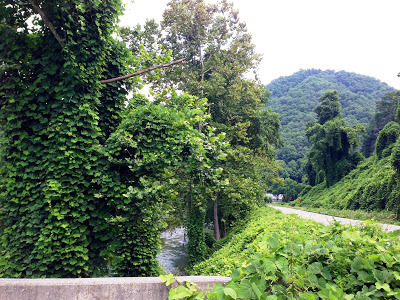
 Kudzu is a trailing vine native to southern Japan and south east China. Its name comes from the Japanese name for the plant, kuzu (クズ or 葛. Kudzu was introduced from Japan into the United States at the Japanese pavilion in the 1876 Centennial Exposition in Philadelphia.
Kudzu is a trailing vine native to southern Japan and south east China. Its name comes from the Japanese name for the plant, kuzu (クズ or 葛. Kudzu was introduced from Japan into the United States at the Japanese pavilion in the 1876 Centennial Exposition in Philadelphia.

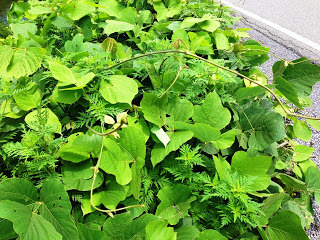
Kudzu, also called Japanese arrowroot, is a member of the pea family. It long coiling vines climb and twine itself around plants and trees. Here in southwestern Virginia, it has no natural enemy and grows like a weed killing other plants in its path by covering them and depriving them of sunlight.
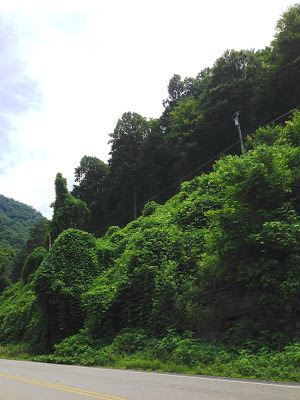 It was introduced to this part of the country as a form of erosion control. It is actually good for the soil, supplying nitrogen, and its deep roots also transfer minerals from the subsoil to the topsoil. But what happens when Kudzu devours every tree and shrub in its path? It suffocates the plant by depriving it of sunlight and oxygen effectively killing its host.
It was introduced to this part of the country as a form of erosion control. It is actually good for the soil, supplying nitrogen, and its deep roots also transfer minerals from the subsoil to the topsoil. But what happens when Kudzu devours every tree and shrub in its path? It suffocates the plant by depriving it of sunlight and oxygen effectively killing its host.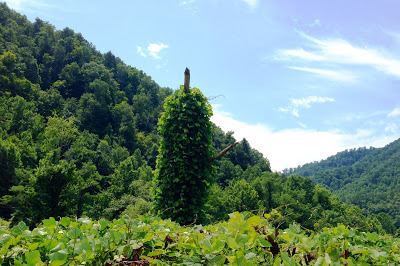 Under this tower of Kudzu is the remains of a tree suffocated by Kudzu.
Under this tower of Kudzu is the remains of a tree suffocated by Kudzu.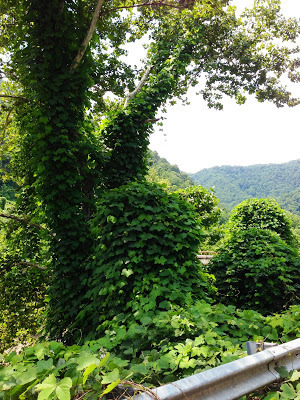 By August, the trees, hillsides, roadsides and creek banks are covered by Kudzu. Every inch of the countryside is a dazzling green landscape.
By August, the trees, hillsides, roadsides and creek banks are covered by Kudzu. Every inch of the countryside is a dazzling green landscape.
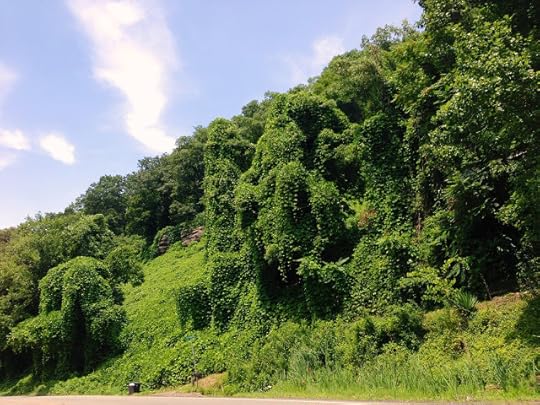
Published on August 04, 2013 13:20



